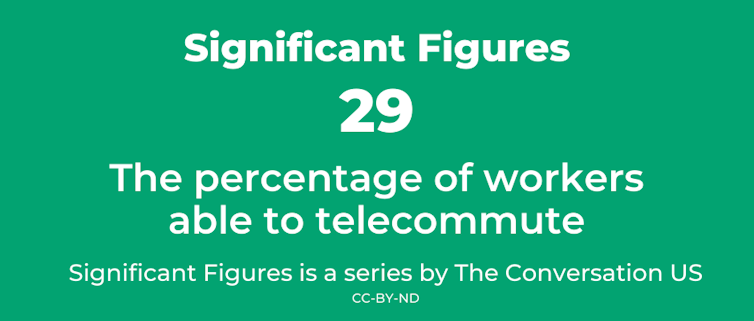Telecommuting could curb the coronavirus epidemic
Two transportation scholars argue that telecommuting could play an important role in solving the coronavirus crisis.


Recent surveys from both the National Household Transportation Survey and the Bureau of Labor Statistics indicate that around 29% of the United States workforce has the option to work at home, and around 15% usually does so.
Working from home pays a double dividend during a pandemic. First, it can help to limit the spread of the highly contagious coronavirus. This supports organizations’ efforts to limit travel and major public events, and more assertive efforts by governments in badly affected regions to restrict population movement altogether.
Restricting travel and canceling events have substantial costs at a time when businesses are already dealing with absences due to illnesses. Allowing people to work from home can help cut some of these losses.
There are many jobs that can be conducted only at a place of work. For example, a dentist can perform a root canal only at an office, a bus driver must drive a bus and a longshoreman must travel to a port.
However, recent advances in digital technologies, software and networks have made working from home much easier. Now many can conduct all or a portion of their work at home, and the data show that some workers from all occupations and industries work from home at some point during the week. What this means is that even the most physical of industries have some jobs or portions of jobs that can be conducted remotely, even if part-time.
Researchers estimate that at least 50% of the workforce has a job that is compatible with working at home for a portion of the week, such as those in sales, legal, media and military occupations. This workforce could contribute to the economy and limit their exposure to the coronavirus.
The limited uptake of working at home has more to do with managerial resistance than the type of work itself. When organizations come together and government provides the necessary resources, flexible workplace strategies have been successful in helping ease traffic during major events such as the 1984 Los Angeles Olympics and maintaining government services during catastrophic weather events such as Snowmageddon in 2010.
[Insight, in your inbox each day. You can get it with The Conversation’s email newsletter.]
The authors do not work for, consult, own shares in or receive funding from any company or organization that would benefit from this article, and have disclosed no relevant affiliations beyond their academic appointment.
Read These Next
The world risks forgetting one of humanity’s greatest triumphs as polio nears global eradication − 7
Polio may finally be defeated in the next 5 years. Will the world recognize what an extraordinary achievement…
RFK Jr. wants to scrutinize the vaccine schedule – but its safety record is already decades long
Federal officials are questioning the safety of the vaccine series children receive. Here’s the story…
Trump tariffs and warming India-China ties have silenced the Quad partnership … for now
A summit between the leaders of the US, India, Japan and Australia was expected in November. But it…






